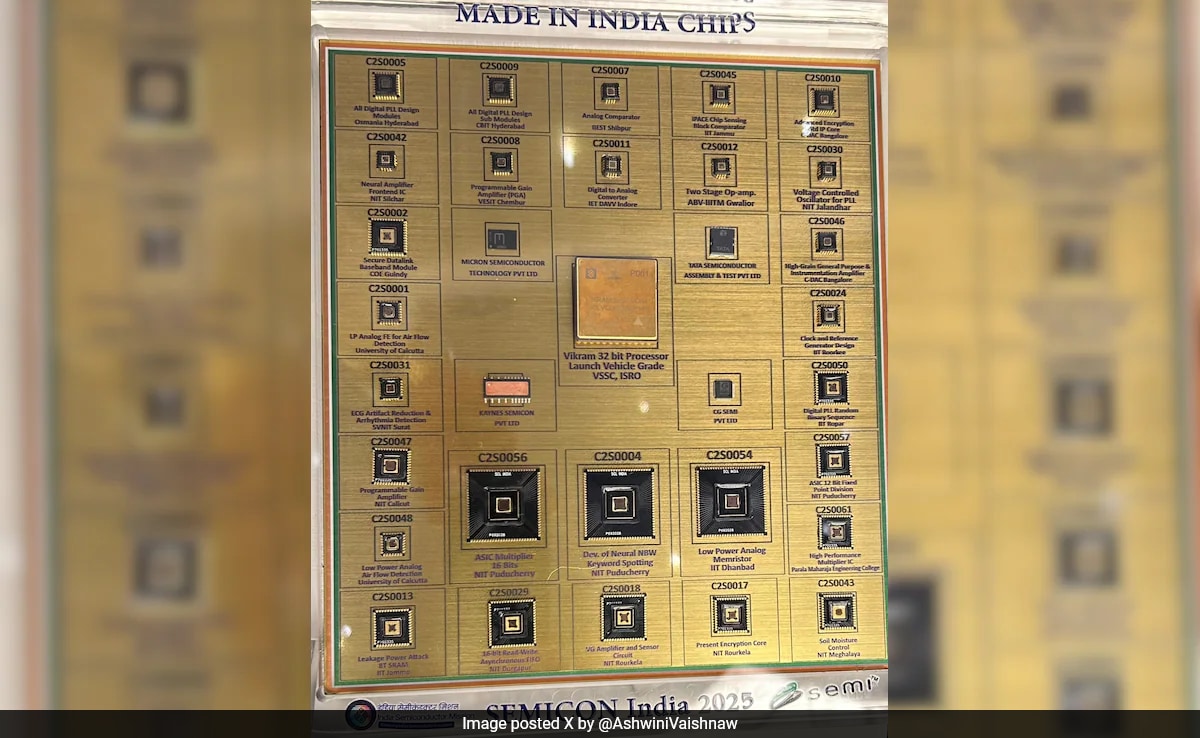
Union Information and Broadcasting Minister Ashwini Vaishnaw on Tuesday presented India's first indigenously developed Vikram-32-bit chip to Prime Minister Narendra Modi at the inauguration of the Semicon India 2025 conference.
Calling semiconductors the "digital diamond" of the modern era, PM Modi said, "Oil was black gold, but semiconductor chips are a digital diamond."
Prime Minister #NarendraModi inaugurates #SemiconIndia2025, where @AshwiniVaishnaw presented him with the first fully Made-in-India chip
— NDTV Profit (@NDTVProfitIndia) September 2, 2025
He presented the Vikram 32-bit processor, developed by ISRO's Semiconductor Laboratory, along with test chips from four approved projects. pic.twitter.com/AnA5IPXA68
What Is The Vikram-32 Bit Chip?
The Vikram-32, officially called VIKRAM3201, is the first fully indigenous 32-bit microprocessor qualified for space missions.

The Vikram-32 chip was designed by the Vikram Sarabhai Space Centre (VSSC).
It has been built by the Indian Space Research Organisation (ISRO)'s Semiconductor Laboratory (SCL), Chandigarh, specifically to withstand the extreme conditions of rocket launches and space environments.
Origin
The Vikram-32 chip was designed by the Vikram Sarabhai Space Centre (VSSC) and fabricated at SCL's 180nm CMOS facility in Mohali, Punjab. It is the successor to VIKRAM1601, a 16-bit microprocessor that has powered ISRO's launch vehicles since 2009. The new processor was formally inducted into ISRO's programme in March, along with another chip called KALPANA-3201.
Features
- The Vikram-32 is built on a 32-bit architecture, which allows it to process larger amounts of data more efficiently.
- It supports floating-point computation, enabling it to handle complex calculations required in aerospace and satellite missions.
- The processor uses a custom Instruction Set Architecture (ISA) tailored to space applications.
- It supports programming in the Ada language, which is widely used in aerospace engineering.
- All supporting software tools, such as the compiler, assembler, linker, and simulator, were developed in-house by ISRO.
- Work is also underway to add support for the C programming language.
Uses Beyond Space
Although the Vikram-32 has been built primarily for satellites and rockets, its rugged design makes it suitable for other critical areas as well. Potential applications include defence systems, aerospace technologies, advanced automotive solutions, and high-reliability energy systems.
The development of the Vikram-32 is a major achievement under the India Semiconductor Mission launched in 2021 and the Design-Linked Incentive (DLI) scheme. It cuts India's dependence on imported microchips and is a big step toward Atmanirbhar Bharat (self-reliant India).
Semicon India 2025
The Semicon India 2025 conference is a three-day event that focuses on building a strong and resilient semiconductor ecosystem in the country. The event includes sessions on chip fabrication, artificial intelligence, advanced packaging, research and development, investment opportunities, and state-level policies.
At the conference, the government announced that it has approved investments worth Rs 1.60 lakh crore across 10 major projects in six states. The construction of five new semiconductor units has already begun. The government is also supporting more than 23 design startups under the DLI scheme.
Track Latest News Live on NDTV.com and get news updates from India and around the world

